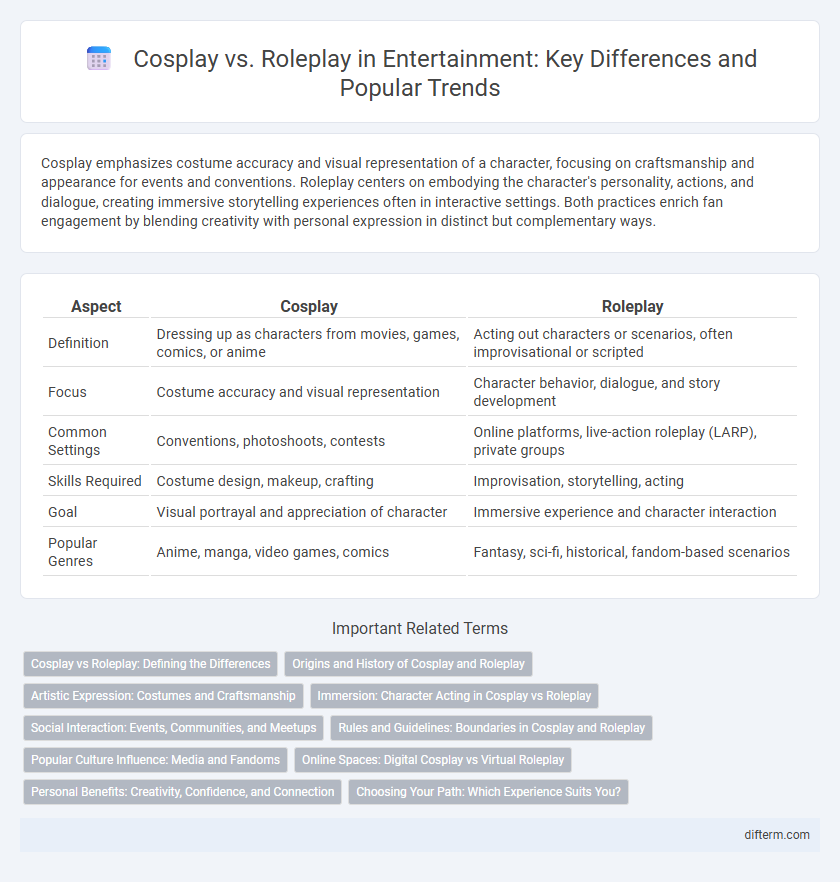Cosplay emphasizes costume accuracy and visual representation of a character, focusing on craftsmanship and appearance for events and conventions. Roleplay centers on embodying the character's personality, actions, and dialogue, creating immersive storytelling experiences often in interactive settings. Both practices enrich fan engagement by blending creativity with personal expression in distinct but complementary ways.
Table of Comparison
| Aspect | Cosplay | Roleplay |
|---|---|---|
| Definition | Dressing up as characters from movies, games, comics, or anime | Acting out characters or scenarios, often improvisational or scripted |
| Focus | Costume accuracy and visual representation | Character behavior, dialogue, and story development |
| Common Settings | Conventions, photoshoots, contests | Online platforms, live-action roleplay (LARP), private groups |
| Skills Required | Costume design, makeup, crafting | Improvisation, storytelling, acting |
| Goal | Visual portrayal and appreciation of character | Immersive experience and character interaction |
| Popular Genres | Anime, manga, video games, comics | Fantasy, sci-fi, historical, fandom-based scenarios |
Cosplay vs Roleplay: Defining the Differences
Cosplay involves fans dressing up as specific characters from anime, movies, or video games, emphasizing costume accuracy and visual representation. Roleplay centers on embodying a character's personality and actions within a narrative or interactive setting, often involving improvisation and storytelling. Understanding these distinctions highlights cosplay's focus on physical appearance versus roleplay's emphasis on character experience and interaction.
Origins and History of Cosplay and Roleplay
Cosplay originated in Japan during the 1970s as fans dressed up at anime and manga conventions, blending "costume" and "play" to celebrate characters visually. Roleplay traces back much earlier, rooted in ancient theatrical traditions and evolving through live-action role-playing (LARP) communities worldwide to simulate characters' behaviors and interactions. Both practices have grown into global phenomena, with cosplay emphasizing visual portrayal and roleplay focusing on immersive character experience.
Artistic Expression: Costumes and Craftsmanship
Cosplay showcases intricate costumes meticulously crafted to embody characters from anime, video games, or movies, highlighting skills in sewing, prop-making, and makeup artistry. Roleplay centers on character embodiment and narrative improvisation, using costumes as tools for immersive storytelling rather than detailed craftsmanship. The artistic expression in cosplay emphasizes visual accuracy and craftsmanship, while roleplay prioritizes emotional and performative authenticity.
Immersion: Character Acting in Cosplay vs Roleplay
Cosplay emphasizes visual accuracy and physical embodiment of a character, enhancing immersion through detailed costumes and props that bring fictional personas to life. Roleplay centers on in-depth character acting and narrative interaction, allowing participants to fully inhabit a character's mindset and emotions within dynamic storytelling environments. Both practices foster immersive experiences but differ in execution: cosplay showcases external authenticity, while roleplay prioritizes psychological and emotional engagement.
Social Interaction: Events, Communities, and Meetups
Cosplay fosters vibrant social interaction by bringing together enthusiasts at conventions and themed events where participants showcase detailed costumes and celebrate shared fandoms. Roleplay communities often thrive online or through intimate meetups, emphasizing collaborative storytelling and character development within immersive scenarios. Both hobbies create dynamic social spaces that encourage creativity, camaraderie, and the forging of lasting friendships among diverse groups.
Rules and Guidelines: Boundaries in Cosplay and Roleplay
Cosplay emphasizes respecting personal boundaries through clearly defined event rules and consent-driven interactions, ensuring safety and enjoyment for all participants. Roleplay requires established guidelines to navigate character behaviors and interpersonal dynamics, prioritizing mutual agreement and emotional comfort. Both practices rely on communication and respect to maintain ethical participation and prevent boundary violations.
Popular Culture Influence: Media and Fandoms
Cosplay and roleplay both draw heavily from popular culture, with media franchises like anime, comic books, and video games serving as primary sources of inspiration. Cosplay emphasizes detailed costume recreation to visually represent characters, while roleplay focuses on embodying the character's personality and actions within fan communities. Media fandoms provide vibrant platforms for enthusiasts to showcase creativity, deepen engagement, and foster social connections through both practices.
Online Spaces: Digital Cosplay vs Virtual Roleplay
Digital cosplay in online spaces involves creating and sharing intricate costume designs, character art, and fan content on platforms like Instagram and TikTok, emphasizing visual representation and craftsmanship. Virtual roleplay, often hosted within MMORPGs and virtual worlds such as Second Life or VRChat, centers on immersive character interaction and narrative development through avatars and real-time communication. Both practices thrive in digital environments but cater to distinct aspects of fan engagement--cosplay highlights aesthetic creativity while roleplay prioritizes interactive storytelling.
Personal Benefits: Creativity, Confidence, and Connection
Cosplay enhances creativity by encouraging participants to design and craft detailed costumes, fostering artistic skills and imaginative expression. Roleplay builds confidence as individuals embody characters, practice social interaction, and develop public speaking abilities. Both activities create strong connections within communities, promoting collaboration, cultural appreciation, and shared enthusiasm for entertainment genres.
Choosing Your Path: Which Experience Suits You?
Cosplay emphasizes detailed costume creation and visual accuracy, appealing to those passionate about embodying characters through appearance and craftsmanship. Roleplay centers on character immersion and storytelling, ideal for individuals who enjoy improvisation and developing character depth in interactive settings. Understanding your preference for either artistic expression or narrative engagement will guide you in choosing the experience that best suits your entertainment style.
cosplay vs roleplay Infographic

 difterm.com
difterm.com